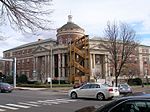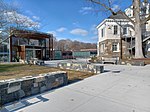Greenwich, Connecticut
1640 establishments in ConnecticutGreenwich, ConnecticutPopulated coastal places in ConnecticutPopulated places established in 1640Towns in Connecticut ... and 2 more
Towns in Fairfield County, ConnecticutTowns in the New York metropolitan area

Greenwich (, GREN-itch) is a town in southwestern Fairfield County, Connecticut, United States. At the 2020 census, the town had a total population of 63,518. The largest town on Connecticut's Gold Coast, Greenwich is home to many hedge funds and other financial services firms. Greenwich is a principal community of the Bridgeport–Stamford–Norwalk–Danbury metropolitan statistical area, which comprises all of Fairfield County. Greenwich is the southernmost and westernmost municipality in Connecticut as well as in the six-state region of New England. The town is named after Greenwich, a royal borough of London in the United Kingdom.
Excerpt from the Wikipedia article Greenwich, Connecticut (License: CC BY-SA 3.0, Authors, Images).Greenwich, Connecticut
Hillside Road,
Geographical coordinates (GPS) Address Phone number Website Nearby Places Show on map
Geographical coordinates (GPS)
| Latitude | Longitude |
|---|---|
| N 41.038888888889 ° | E -73.613611111111 ° |
Address
Greenwich High School
Hillside Road 10
06830
Connecticut, United States
Open on Google Maps









